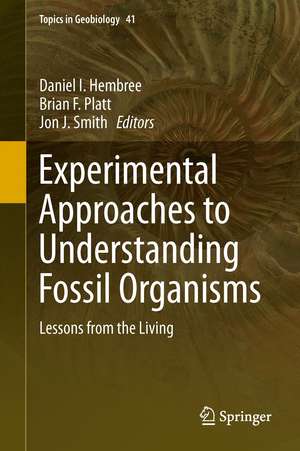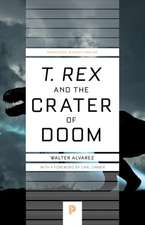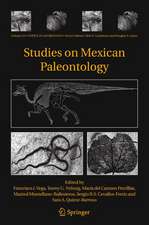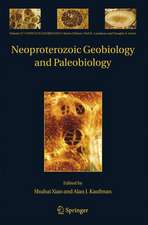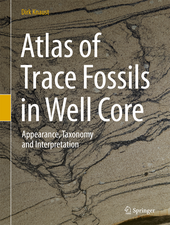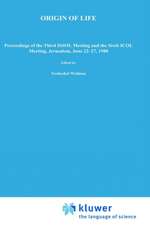Experimental Approaches to Understanding Fossil Organisms: Lessons from the Living: Topics in Geobiology, cartea 41
Editat de Daniel I. Hembree, Brian F. Platt, Jon J. Smithen Limba Engleză Hardback – 14 mai 2014
| Toate formatele și edițiile | Preț | Express |
|---|---|---|
| Paperback (1) | 1223.55 lei 6-8 săpt. | |
| SPRINGER NETHERLANDS – 3 sep 2016 | 1223.55 lei 6-8 săpt. | |
| Hardback (1) | 1229.10 lei 6-8 săpt. | |
| SPRINGER NETHERLANDS – 14 mai 2014 | 1229.10 lei 6-8 săpt. |
Din seria Topics in Geobiology
- 18%
 Preț: 1858.10 lei
Preț: 1858.10 lei - 20%
 Preț: 822.08 lei
Preț: 822.08 lei - 15%
 Preț: 672.43 lei
Preț: 672.43 lei - 18%
 Preț: 1236.82 lei
Preț: 1236.82 lei - 15%
 Preț: 647.59 lei
Preț: 647.59 lei - 24%
 Preț: 885.02 lei
Preț: 885.02 lei - 18%
 Preț: 951.59 lei
Preț: 951.59 lei - 18%
 Preț: 964.23 lei
Preț: 964.23 lei - 18%
 Preț: 1117.69 lei
Preț: 1117.69 lei - 15%
 Preț: 633.31 lei
Preț: 633.31 lei - 18%
 Preț: 966.27 lei
Preț: 966.27 lei - 18%
 Preț: 952.54 lei
Preț: 952.54 lei - 18%
 Preț: 949.85 lei
Preț: 949.85 lei - 18%
 Preț: 1013.50 lei
Preț: 1013.50 lei - 24%
 Preț: 821.17 lei
Preț: 821.17 lei - 18%
 Preț: 952.40 lei
Preț: 952.40 lei - 18%
 Preț: 961.23 lei
Preț: 961.23 lei - 18%
 Preț: 952.26 lei
Preț: 952.26 lei - 18%
 Preț: 960.42 lei
Preț: 960.42 lei - 18%
 Preț: 1843.11 lei
Preț: 1843.11 lei - 18%
 Preț: 954.31 lei
Preț: 954.31 lei - 18%
 Preț: 1256.41 lei
Preț: 1256.41 lei - 18%
 Preț: 959.50 lei
Preț: 959.50 lei - 15%
 Preț: 673.60 lei
Preț: 673.60 lei - 18%
 Preț: 954.14 lei
Preț: 954.14 lei - 15%
 Preț: 640.06 lei
Preț: 640.06 lei - 18%
 Preț: 959.36 lei
Preț: 959.36 lei
Preț: 1229.10 lei
Preț vechi: 1498.90 lei
-18% Nou
Puncte Express: 1844
Preț estimativ în valută:
235.24€ • 244.64$ • 196.85£
235.24€ • 244.64$ • 196.85£
Carte tipărită la comandă
Livrare economică 15-29 martie
Preluare comenzi: 021 569.72.76
Specificații
ISBN-13: 9789401787208
ISBN-10: 9401787204
Pagini: 440
Ilustrații: XVII, 420 p. 130 illus., 45 illus. in color.
Dimensiuni: 155 x 235 x 29 mm
Greutate: 0.77 kg
Ediția:2014
Editura: SPRINGER NETHERLANDS
Colecția Springer
Seria Topics in Geobiology
Locul publicării:Dordrecht, Netherlands
ISBN-10: 9401787204
Pagini: 440
Ilustrații: XVII, 420 p. 130 illus., 45 illus. in color.
Dimensiuni: 155 x 235 x 29 mm
Greutate: 0.77 kg
Ediția:2014
Editura: SPRINGER NETHERLANDS
Colecția Springer
Seria Topics in Geobiology
Locul publicării:Dordrecht, Netherlands
Public țintă
ResearchCuprins
Part I Functional Morphology.- Part II Taphonomy and Environment.- Part III Organism-Substrate Interaction.
Recenzii
“The volume edited by Hembree et al. is a must read to specialists in experimental palaeontology. lt is also recommended strongly to professional palaeobiologists and ichnologists. Researchers in fossil arthropods, bivalves, crinoids, mammals, and some other creatures will find much useful there, too. Finally, some geochemists and sedimentologists have to pay attention to this book.” (Dmitry A. Ruban, Zentralblatt für Geologie und Paläontologie, Vol. 2016 (3-4), December, 2016)
“This edited volume consists of 17 chapters organized into three parts: functional morphology, taphonomy and environment, and organism-substrate interaction. … This volume will be of particular use for graduate students and those teaching graduate-level methods courses, where one can examine and compare numerous experimental designs and analytical techniques. … there is much to recommend in this comprehensive and well-written volume for the student and professional paleobiologist … .” (Christopher R. Noto, The Quarterly Review of Biology, Vol. 91 (3), September, 2016)
“This edited volume consists of 17 chapters organized into three parts: functional morphology, taphonomy and environment, and organism-substrate interaction. … This volume will be of particular use for graduate students and those teaching graduate-level methods courses, where one can examine and compare numerous experimental designs and analytical techniques. … there is much to recommend in this comprehensive and well-written volume for the student and professional paleobiologist … .” (Christopher R. Noto, The Quarterly Review of Biology, Vol. 91 (3), September, 2016)
Notă biografică
Daniel I. Hembree, Associate Professor, Department of Geological Sciences, Ohio University; PhD University of Kansas 2005.
Brian F. Platt, Assistant Professor, Department of Geology and Geological Engineering, University of Mississippi; PhD University of Kansas 2012.
Jon J. Smith, Assistant Scientist, Stratigraphic Research Group, Kansas Geological Survey; PhD University of Kansas 2007.
Brian F. Platt, Assistant Professor, Department of Geology and Geological Engineering, University of Mississippi; PhD University of Kansas 2012.
Jon J. Smith, Assistant Scientist, Stratigraphic Research Group, Kansas Geological Survey; PhD University of Kansas 2007.
Textul de pe ultima copertă
Paleontologists and geologists struggle with research questions often complicated by the loss or even absence of key paleobiological and paleoenvironmental information. Insight into this missing data can be gained through direct exploration of analogous living organisms and modern environments. Creative, experimental, and interdisciplinary treatments of such ancient-Earth analogs form the basis of this volume. It unites a diverse range of expert paleontologists, neontologists, and geologists presenting case studies that cover a spectrum of topics, including functional morphology, taphonomy, environments, and organism-substrate interactions.
Caracteristici
Unifies an array of diverse topics in geobiology through the shared approach of using the present as the key to the past Tackles intriguing paleontological questions through creative, tangible, real-world experiments with modern analogous organisms and environments Represents advances in multiple paleontological and sedimentological fields and provides those familiar with the subject with new results and unique perspectives Includes supplementary material: sn.pub/extras
